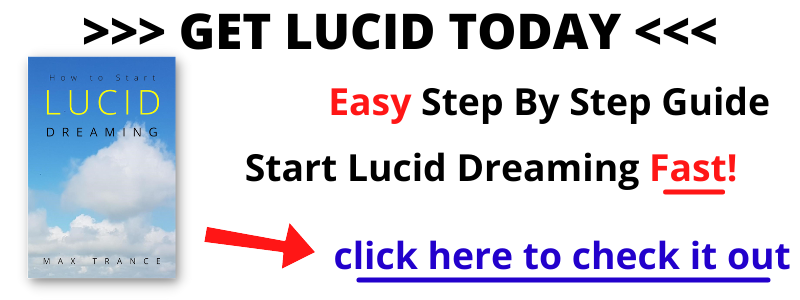I was recently doing some research for my new lightning introduction to lucid dreaming eBook to make sure I was fully up-to-date, and I came across some interesting posts about fears that people have around the dangers of lucid dreaming.
Some of the fears people have around lucid dreaming are real, while others are imagined. Ultimately, lucid dreaming is a very safe activity. There are only two dangers that have any basis in reality. First, you might mess up your sleep patterns if you use the wrong approach to inducing your lucid dreams. And second, in bridging the gap between the dream world and the waking world, it can become harder to tell them apart. In this article I’ll cover each of these, along with some of the other perceived dangers of lucid dreaming.
Is Lucid Dreaming safe?
The short answer is that, yes, lucid dreaming is a very safe thing to do.
If you take a few moments to think about it, at its core a lucid dream is nothing more than a regular dream with the distinction that we’re consciously aware inside it. In practical terms, this means that the only things that might potentially be unsafe about it have to do with not getting enough sleep.
A lucid dream is nothing more than a regular dream in which we know we’re dreaming.
What it boils down to is that people have concerns that if they are awake during their dreams, they aren’t sleeping in the way they normally do, so they might not get the usual benefits of sleep.
All I can say about this is that I’ve been experiencing lucid dreams for years, and have not noticed any negative effects on how refreshed I feel afterwards. If anything, I feel more refreshed when I wake up after I have a lucid dream than when I wake up after I haven’t.
Avoid Wake Back to Bed if You Can
Now, there are quite a few methods that people use to induce lucid dreams. A popular method is known as Wake Back to Bed, which involves setting an alarm for approximately 3 sleep cycles after you fall asleep, waking yourself up, doing something for 20 minutes or so, then going back to sleep.
It should come as no surprise to anyone that if you follow the Wake Back to Bed method, you are putting yourself at risk of having worse sleep. That’s kinda an expected side-effect when you wake yourself up in the middle of the night with an alarm.
Use the Wake Back to Bed method to cause low-quality sleep. Or better still, don’t.
In fact, the only way you wouldn’t have a worse night’s sleep with the Wake Back to Bed method is if you somehow managed to time your alarm perfectly for the end of one of your sleep cycles. Since most people cannot fall asleep in a predictable amount of time after they go to bed, this is quite difficult to achieve.
Luckily there are lots of other ways that you can induce lucid dreams. My preferred method is to simply move directly from being awake into a lucid dream. I cover how I do this in my book, Lucid.
My view is that so long as you avoid the wake back to bed method, you are unlikely to have any negative side effects from lucid dreaming.
Myths about Lucid Dreaming
Before we get onto the dangers of lucid dreaming, it’s important to cover off some myths. As with hypnosis, there are a number of things that people can come to believe about lucid dreaming that just aren’t true. The main reason that these come up is that people can be resistant to change to the extent that they will often make things up rather than experience something new.
So what are some common myths and fears about lucid dreaming?
Getting stuck in a lucid dream
A lot of people worry that they might get stuck inside a lucid dream. There are two parts to this.
First, you are no more likely to get stuck inside a lucid dream than a regular dream. Our brains need to dream in order for us to remain sane. The only time people get stuck in an unconscious state is when they are in a coma. Now, I don’t know much about comas, but I can say this: if I was stuck in a coma, I would want to be lucid dreaming. At least that way I could be aware and doing things.
And second, even if you did find yourself stuck inside a lucid dream, there’s not really any way that can be a bad thing. Even if you experience 50 years in dream time, you’re still going to wake up at the time you would have in the waking world. You just get to have that bonus 50 years where you’re in total control.
Dying in real life from a lucid dream
I’ve come across people who believe that you can die in real life from things that happen inside a dream. This idea probably comes from movies and general popular culture where there is a reasonably common theme of someone dying in their dreams and that flowing through to real life.
Now, no-one can say for certain that you can’t die from something that happens inside your dreams. In fact, the reality is that you probably can. If you happen to have a heart condition to the extent that a sudden shock could kill you, it’s almost certainly possible to have those shocks inside your dreams.
And the fact is that countless people die in their sleep every year.
So let me ask you this: if you had a heart condition that was that bad, would you rather have regular dreams where some random event might kill you at any time? Or would you prefer to have lucid dreams where you’re in control and there aren’t any random events unless you specifically choose them?
Looking at it this way, it’s quite clear that lucid dreams are safer than regular dreams with regard to dying in them.
Becoming addicted to lucid dreaming
With everything we do, there is a chance that we will become addicted to it, so it should come as no surprise that there are people who worry that they might become addicted to lucid dreaming.
Addictions tend to form when there is a process we can follow that gives us a reward that we cannot predict. This is why social media platforms are so compelling. When we make a post, we never quite know how it will be received. Some go viral and take off, while others die a quiet death, unseen by just about everyone. And the thing is, when we make the post, most of us have no idea which ones will go viral and which ones won’t.
Addictions tend to form when the reward from an activity is independent of our actions.
If you think about scrolling through the feed, it’s the same thing. Most of it is crap that you skip past, with the occasional gem.
From our perspective, it’s random.
Once we get good at lucid dreaming, and can reliably cause lucid dreams to happen on demand, we’re in control of the reward. This is exactly the opposite of what causes addiction.
Sleep paralysis being caused by lucid dreaming
When you look into lucid dreaming, one of the things you will come across very quickly is that people who lucid dream tend to experience sleep paralysis a lot more than those who have regular dreams.
From this, they conclude that sleep paralysis is caused by lucid dreaming.
In reality, it’s the other way around.
You see, our brains have this wonderful mechanism that prevents us from coming to harm from acting out our dreams. Every time we dream, our brain paralyzes us. This is a completely natural and safe process. In fact, if we didn’t have sleep paralysis, we would probably come to harm very quickly.
Now, when we dream lucidly, we’re in control, which means that we can end up waking up while the sleep paralysis is still in effect.
When we dream normally, we’re not in control, so there is a higher level of synchronization between sleep paralysis and our sleep cycles.
This is nothing to be afraid of.
If you wake up and find yourself experiencing sleep paralysis, all you have to do is wait a bit and think about things other than the sleep paralysis, and it will very quickly clear all by itself.
What are the dangers of Lucid Dreaming?
So now that we’ve covered the myths that people have around lucid dreaming, we come to the actual dangers.
Mental health
Lucid dreaming is generally regarded as a very safe thing to do.
However, if you have mental health issues of any kind, it tends to be a good idea to check with your mental health professional before engaging in any new kind of mental process.
This includes lucid dreaming. While it’s safe and useful for most of the population, it’s always prudent to check with the relevant professional when you have issues that might be impacted by something new you’re trying.
Sleep paralysis
As mentioned in the previous section, even though sleep paralysis is not caused by lucid dreaming, it can still occur, and can be scary when it happens to us.
The main thing with this one is to be aware that it can happen. When you know that it’s a completely natural and useful process that happens every time we dream, there’s no reason to worry if you wake up and find it still in effect.
Hallucinations
One of the important skills that we nurture and build when we’re learning to lucid dream is the ability to recall our dreams.
The way we do this is effectively by building a bridge between our dream world and our waking world. Perceptually speaking, a dream is a form of hallucination. We’re experiencing things that aren’t really there. So when we build this bridge, in a sense we’re also teaching ourselves to hallucinate while we’re awake.
Part of the skill of lucid dreaming is building a bridge between our hallucinated dream world and the waking world.
This means that it can become possible for us to gradually lose the ability to tell the difference between what’s real and what’s a dream.
How to Stop Hallucinations Caused By the Dream Bridge
Luckily there’s a simple solution, and it’s built into how we become lucid in the first place.
An important part of lucid dreaming is building the habit of carrying out reality checks to establish whether we’re awake or dreaming. A reality check is nothing more than us trying to do something physical that would be impossible in the waking world, such as pushing your hand through some solid object.

As you might imagine, if we start to hallucinate while we’re awake, it becomes possible that we perceive our reality checks as showing us that we’re dreaming when we’re still awake. We try to push our hand through our desk, and we believe it worked, even though we’re awake.
The solution to this is simple: if your reality check shows you that you’re dreaming, do some more different reality checks straight away to build your confidence that you are actually dreaming.
Perform multiple reality checks in sequence to build your confidence that you’re dreaming.
Here’s an example.
Suppose that your reality check is pushing your hand through your desk. If your hand goes through your desk, this is normally a sign that you’re dreaming. So the very next thing to do is try something else. For example, get up and try to push your hand through the door. If that works, very slowly try to walk through the door. Try to levitate off the ground and discover what happens.
Because here’s the thing: when we are far enough inside an hallucination, there’s a good chance that we’re asleep and dreaming.
If taken far enough, this bridge between our dreams and our waking world can also cause us to start to become dissociated from ourselves, reality, or both, so it’s important to regularly test what state we’re in with our reality checks.
Messed up sleep patterns and not enough sleep
Some people report not feeling as rested after lucid dreaming, while others report the opposite.
The truth is that if you engage in things that change your sleep patterns, there may be an adjustment period. When not done properly, messed up sleep can become one of the dangers of lucid dreaming. It’s also important to ensure that you’re still getting enough sleep each night when you lucid dream.
As I mentioned previously, the Wake Back to Bed method of inducing lucid dreams can result in worse sleep. Practically speaking, if you find that you’re sleeping less well after lucid dreaming, it’s probably not the lucid dreams themselves, but rather the method that you’re using to get there.
Luckily there are lots of other ways to induce lucid dreams. My preferred method is to simply move directly into a lucid dream from being awake. And if you get good enough at reality checks, just about any dream you have can become lucid.
There is a significant amount of evidence that poor sleep can lead to other psychological issues, such as depression and anxiety, so it’s important to pay attention to how you’re sleeping and take appropriate steps to ensure that you get enough high quality sleep each night.
Lucid nightmares and meeting demons
Something that people will sometimes report is that they’ve had a nightmare inside a lucid dream.
Here’s the thing though. Nightmares happen when we have a negative focus while we’re dreaming. They’re not really dependent on lucidity at all in that regard.
And there’s a bonus that we get when we know how to lucid dream: If we find ourselves inside a lucid nightmare, we’re in control, so we can simply choose to change it to something else.
It’s the same thing with meeting demons. You’re the one who’s in control inside your lucid dreams, so if anything happens that you don’t like, you get to change it.
Poor sleep quality
Some have worried that lucid dreaming may result in poor sleep quality.
The interesting thing about this is that there are people firmly in both camps. Some people find that they feel less rested after lucid dreaming, while others report significant improvement in how rested they feel.
This should be an indication to everyone that it’s not lucid dreaming that’s causing the poor quality sleep. The fact remains that at this point in time, no-one really knows whether lucid dreaming results in better or worse quality of sleep.
All I could suggest in this regard is try it out and see what happens for you. If you find that you always feel less rested after lucid dreaming, you can either sleep more to compensate for it, or you can stop lucid dreaming.
I have a very strong suspicion that the only reason some people report poor quality sleep is that they are using the Wake Back to Bed method.
How to Lucid Dream safely
So to finish up, how exactly do we overcome the dangers of lucid dreaming so that we can lucid dream safely?
It’s actually really easy.
You see, our dreams reflect our waking lives to some extent. That’s why reality checks work.
If you want to have good lucid dreams, it will benefit you greatly if you develop the habit of practicing mindfulness in your waking life. This will then flow through to your dreams, lucid or otherwise.
There’s an easy way to start practicing mindful meditation in my article on How to Meditate When You Have No Time.
And if you’d like to learn how to lucid dream, you can find a comprehensive, step-by-step guide in my book Lucid: How to Start Lucid Dreaming Even if You Never Remember Your Dreams.




